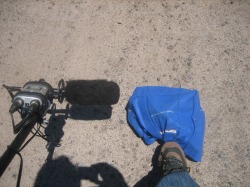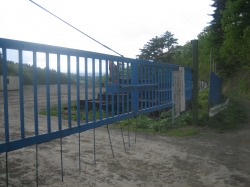|
I finally found some very old source material I have been looking for for ages. I knew I had it somewhere and I wanted to add it to the library. Years ago I was working on a pitch for a game project that subsequently went nowhere, but I did enjoy making some of the sounds for it. One of the primary sounds was a giant explosive scream that the main character had as an ability. It was supposed to be pretty much the biggest thing int he game and as such needed a big sound. I spent some time at home screaming into a mic to get some good raw material to work from. It was that the screams are particularly brilliant, although I do think they worked fairly well, it is more that it took over a week for my throat to heal as I seriously damaged it from screaming so loud. For this reason alone I wanted to make sure the sounds found their way into the library because I am certainly not going to try and record them again. Looking back at the old project files I can see how I put it together and even now its not too bad an end result. I think I was having so much fun working on it that I really put a lot of effort into the final sound. This would have been 8 years ago at least and back then I didn't spend the same amount of time on recording raw material, so I am really glad I found the old source material for this. I won't add the final sound to the library, but I will put it hear as a taste of some of the crazy things I used to get up to working on pitch ideas.
1 Comment
Location Royal Park Melbourne Equipment Zoom F4 Sennheiser MKH 60 Boom pole array As part of a new project I am working on I need a large number of impact sounds to represent people hitting the ground in various ways. Basically body fall sounds. I have made a few of these in the past for smaller projects but I never committed any of them to the library so I thought I would be extra prepared today and record a huge amount. In the past I have read various forums and had discussions on the audio mailing list I am on with people about how to make good convincing sounds of people or bodies hitting the ground. There are several elements that make up a good body fall sound, obviously the impact itself, but all the sounds need to have a softer organic feel to them than the sound of a brick hitting the ground. People have suggested using empty boxes to create a good low thud, as well as sacks of potatoes for a good weighty sound. I discovered a rough combination of these tow works pretty well. The sack of potatoes is a good idea because it is not a rigid item, it will bend and flex as it tumbles and falls in a similar way to a human body, but it lacks the convincing thud sound that a hollow container like a box produces. My approach was to use a cloth bag and fill it full of shoes or boots. They have enough weight to fall convincingly and the hollow nature of each shoes acts as a small sound box. Because there are several shoes in the bag you also get the flexible nature similar to having a bag of potatoes at about a quarter of the weight. So armed with my bag of boots I went over to the park. One of the big disadvantages of being back in Melbourne and specifically in the CBD area is that it is completely impossible to find somewhere away from noise contamination. The best I can do is limit it as much as possible. I walked across to Royal Park and made my way down to a small reserve area near the back of the zoo. Although there were both train and tram lines running nearby, there were no roads close by. This meant that I could mostly record without too much background noise. Melbourne’s Public transport system is crap enough that the trains only come along every ten to twenty minutes and the trams aren’t much better. For once this was actually beneficial to me. I spent the best part of an hour pushing, kicking, tossing, swinging and generally throwing around my bag of boots. (I think some of the people in the nearby sports stadium were convinced I was completely insane and possibly quite dangerous)
Generally when I am trying to record new sounds that I am creating myself (i.e. Foley) I try to think of as many ways as possible to manipulate the items I am working with to see what I can come up with. As I said I used the bag of boots in many different ways, but I also took the boots out and banged them together, banged them on the ground, swung them by their laces onto the ground, scraped them along the ground etc etc. The amount of material I sampled should allow me to add a huge number of new body impact sounds to the library. I ended up with all the boots in the bag all tied up kicking along the road for about a kilometre. I kicked it across gravel, road, grass, getting it to tumble slide and bounce along the way. It’s going to be time consuming going through and cutting up all the material but I am looking forward to what I can get out of it. Looks like another good days recording. Location Sannohe Equipment Zoom F4 Sennheiser MKH 60 Boom pole array As part of the process to extend the non metallic sections of the materials library I set out to record a series of glass breaking samples today. Having access to a remote unused depot in a quiet spot on a mountain certainly helped the process. Using some discarded mirrors about 50cm square I recorded various samples of glass breaking through being dropped and impacted upon. It took a few shots to get the levels exactly right but I captured some good material. Two things I learnt from this session. Firstly I decided not to break all of the 12 plates of glass I had with me. I thought it might be a good idea to save some of them for a second session just in case there were any issues with the material. While it is possible to check the material on site, it is often not until you return to the studio that you discover issues with levels, unknown sound contamination and various other unexpected issues. Especially when dealing with a limited resource (I only had 12 plates to smash) it may be wise to plan for 2 sessions allowing you to redo anything that didn’t work. In this case the material was good, but the second session I am going to use the remaining plates to simulate things piercing glass. I will reinforce some of the plates with tape and then use projectiles to punch through the glass hopefully getting a good simulation of bullets breaking glass. The second thing I learnt is that glass takes a long time to clean up. I took along several containers to collect all the shrapnel in and a brush and shovel to help me collect the pieces. Glass however literally explodes when it breaks and 70% of my time was spent after recording hunting down glass shards. The glass was then added to the recycling pile for the next collection. It’s also a really good idea to wear protective gear when dealing with glass. I did and was glad of it. Location
Sannohe Japan Equipment Zoom F4 Sennheiser MKH 60 Tripod floor stand & Roland R09 Propped up. A friend challenged me recently to create a specific sound for him, and I realized I had not as yet recorded any organic Foley sounds for the library. I want to have fairly large range of organics for various uses so I thought this was a good opportunity to get some. I doubled the usefulness of the time spent by actually preparing dinner at the same time. In this manner I got a good range of domestic sounds of chopping cutting and peeling vegetables as well as some good Foley suitable to represent bones cracking and splitting, skin tearing and various other unpleasant organic sounds. I’ll create sound effect to add to the created section to demonstrate the kinds of things these sounds can be used for. |
AuthorStephan Schütze has been recording sounds for over twenty years. This journal logs his thoughts and experiences Categories
All
Archives
April 2019
|


 RSS Feed
RSS Feed
